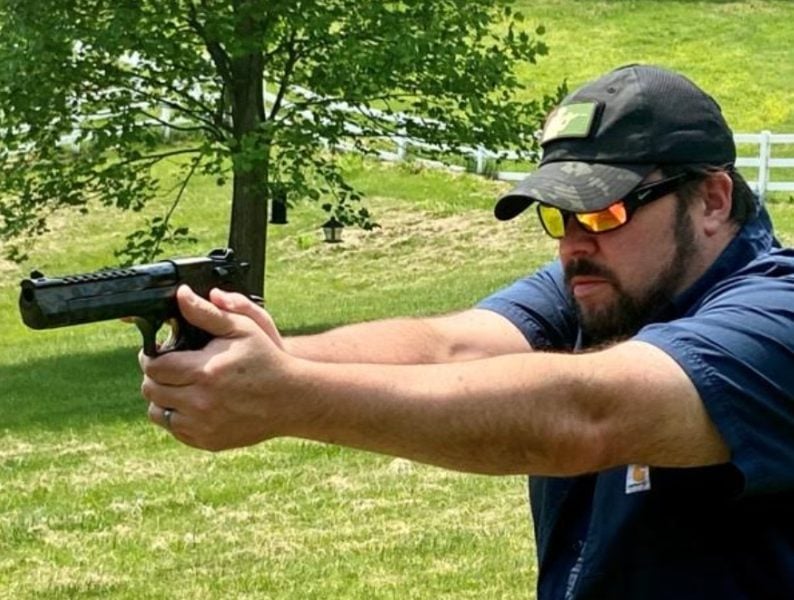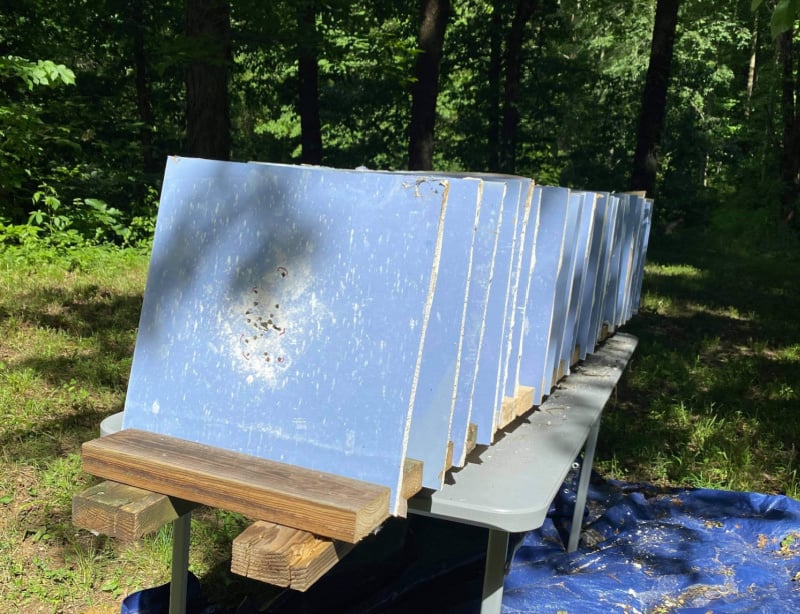“You’re thinking “Did he fire six shots or only five?” Now to tell you the truth, I’ve forgotten myself in all this excitement. But being this is a .44 Magnum, the most powerful handgun in the world and will blow your head clean off, “you’ve got to ask yourself a question: ‘Do I feel lucky?’ Well, do ya, punk?” -Dirty Harry 1971.

Though I did not see “Dirty Harry” when it was first released I have a distinct memory of watching it with my dad around 1977-1978. My fascination with ‘big bore’ handguns officially began. The first .44 Magnum I bought was a Colt Anaconda and it wasn’t until many years later that I bought a ‘Dirty Harry’ edition of his classic Smith & Wesson Model 29 from the movie. The phrase “most powerful handgun in the world” would continue impacting my purchases, to some degree, until this very day.
The Desert Eagle History
I once heard someone refer to the Desert Eagle as a ‘solution to a problem no one ever had’ and I honestly can’t strongly disagree from a usefulness perspective. But if the problem was ‘can we make a semi-automatic more powerful than the .44 magnum revolver’ then maybe that is a good enough problem to justify a solution. In the world of firearms, there is room for safe queens, range guns, competition guns, and duty guns. Not all guns have to have clear usefulness for everyday use. Sometimes it is OK to build a gun, just because it can be done.
Design of this gun began in 1979 at Israeli Military Industries (IMI) and it was released in 1983. It has been produced continuously since then. First, it was made by IMI from 1983 to 1995, then Sarco Defense from 1995 to 1998. Then it went back to IMI from 1998-2005). Israeli Weapons Industries (IWI) and Magnum Research made it from 2005-2009. From 2009 to the present, it is being made just by Magnum Research. During all that time there have been three primary versions. The Mark I was produced from 1983-1990. The Mark VII was made from 1990-1995. And, the Mark XIX has been made from 1995 to the present.
The Mark I was chambered in .44 Magnum or .357 Magnum. In 1995, the Mark VII added .41 Magnum and shortly before being transitioned to the Mark XIX the .50 Action Express round, specifically designed for the Desert Eagle. The Mark XIX has featured chambering including .357 Magnum, .41 Magnum, .429 DE, .440 Cor-Bon, .44 Magnum, and .50 AE.
All versions of the Desert Eagle have a gas-operated ejection and chambering system with a rotating bolt with locking lugs more resembling a rifle like the AR-15 or Ruger Mini-14 than traditional semi-automatic handguns. This gas-operated system allows for the chambering of more powerful rounds than normally seen in semi-automatic handguns.
My History with the Desert Eagle

I first had the opportunity to shoot a .44 Magnum Mark I Desert Eagle in 1990 at an outdoor range in Illinois. A friend of a friend had a matched set of .44 Magnum Desert Eagles and let everyone shoot a magazine from one or both. I wouldn’t say I was absolutely hooked. I did not see much value in the larger capacity of eight rounds of .44 Magnum over the six rounds in a revolver when compared to the added complexity and weight of the Desert Eagle. In short, I liked my Colt Anaconda in .44 Magnum more.
That changed in 1995 when I first saw the Model VII for sale chambered in the new .50 AE. Within a year I pulled the trigger and bought my first Desert Eagle. Anyone who knows me, knows I am a sucker for new rounds. A .50 caliber round specifically designed for the Desert
Eagle was too much for me to resist. Though down to seven rounds with .50 AE, this initial IMI Mark VII Desert Eagle would be followed by additional Mark XIXs over the years.
The one consistency in my Desert Eagles has been that they have all been chambered in .50 AE. The one exception is a Desert Eagle set that contained conversions for all three major chamberings (.50 AE, .44 Magnum, and .357 Magnum). My most recent purchase was in late 2022 when I couldn’t help myself and bought the newest Magnum Research version in a case-hardened finish. Honestly, it is the ballistic support for the .50 AE, mainly due to bullet weight, that keeps me coming back.

Ballistic Tests: .50 AE, .44 Magnum, and .357 Magnum
I put the ballistics of the .50 AE to the test using a Desert Eagle XIX that came with a set of conversions. This allowed the same gun to be configured in .50 AE, .44 Magnum, and .357 Magnum. For each test, I fired seven rounds of defensive ammo with muzzle velocity and muzzle energy measured with a Lab Radar chronometer.
Comparing the ballistics of Hornady XTP rounds of .357 Magnum, .44 Magnum, and .50 AE, the .44 Magnum at 1552 ft/sec. and the .357 Magnum at 1495 ft/sec. both had slightly higher muzzle velocities than the .50 AE at 1470 ft/sec. However, looking at muzzle energy the .50 AE is the clear winner — 300gr bullet with a muzzle energy of 1449 compared to the .44 Magnum 180gr bullet with a muzzle energy of 960 or the .357 Magnum 125gr bullet with a muzzle energy of 624. When looking at penetration, the .50 AE round generally penetrated slightly further than the .44 Magnum and both outperform the .357 Magnum.

I tested these three rounds on sheets of ½” sheetrock spaced at 3.5” intervals. So, every two sheetrock panels penetrated would be the equivalent of one interior wall. The .50 AE penetrated 20 sheets on average, the .44 Magnum, 18 sheets, and the .357 Magnum penetrated 15 sheets. Others have found similar results (.50 AE slightly outperforming .44 Magnum) looking at phone books, bricks, and pine wood panels as well as ballistic gel.
Though less scientific, the amount of debris and powdered sheetrock smoke from the .50 AE was noticeably more than either of the Magnum rounds. In other words, the .50 AE had a much better ‘Yee-Haw’ factor when shooting.
Desert Eagles, Huh, Yeah, What is it Good For?
The cons to using a Desert Eagle are many including:
- Weight: Three times more than a Glock 17.
- Size: Well over 2” longer than most full-frame handguns.
- Limited capacity: Seven to nine rounds compared to 15-17 in most other semi-automatics.
- Large grip surface: 7.5″ grip circumference on a Desert Eagle compared to 5.5″ on a Glock 17.
- Recoil
- The list goes on and on.
Though I would consider myself decently accurate with my Desert Eagles, I am in no way fast with them. The felt recoil and muzzle flip requires more time to get back onto the sight picture after every round fired. Finally, I have shot 10,000s of rounds out of my Glock 17s with so few malfunctions I honestly can’t remember any, though I am sure I have had a few bad rounds over the years.
By comparison when fully cleaned and oiled my Desert Eagles run with no issue. But it only takes 50 or so rounds before malfunctions — generally failure to fully feed — start cropping up. Is this due to grit from spent rounds, oil baking off, or are my hands and grip just getting tired? I will leave that to you to decide, but for me, the gun just isn’t reliable enough for any defensive use.
There are only two military or police forces in the world that list the Desert Eagle as used, even after it has been in service for 40 years. The Polish special forces use them only in training. The Portugal special forces have them available for use in .357 Magnum. But if the Desert Eagle has seen almost no duty use in its 40 years, that is balanced with over 600 films, shows, and games featuring this gun.
For me, there are many reasons to own a firearm. While the Desert Eagle may not pass any realistic muster as a defensive use firearm, it excels as a range gun that always attracts interest and as an icon of movies and media. Of all my guns, my Desert Eagles are the most requested when friends want to shoot some of my guns. Additionally, there is a certain thrill when watching Arnold Schwarzenegger wield one or when Deadpool fires two of them as his primary firearms.

All things being equal I am glad I own these guns. I will likely be drawn back to the fold as new finishes or rounds are made available. After all, I still haven’t picked up the Desert Eagle in gold zebra stripes.


